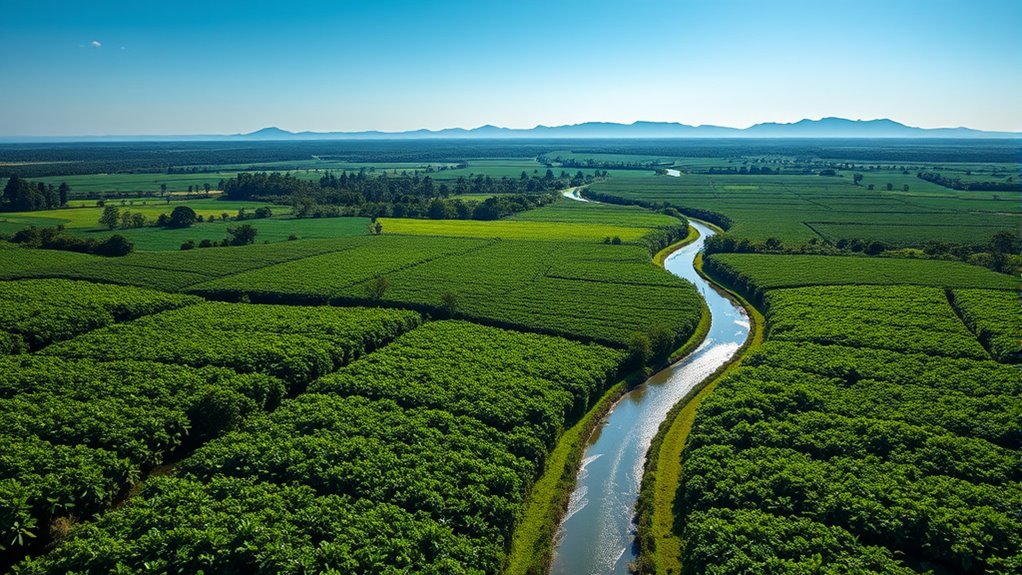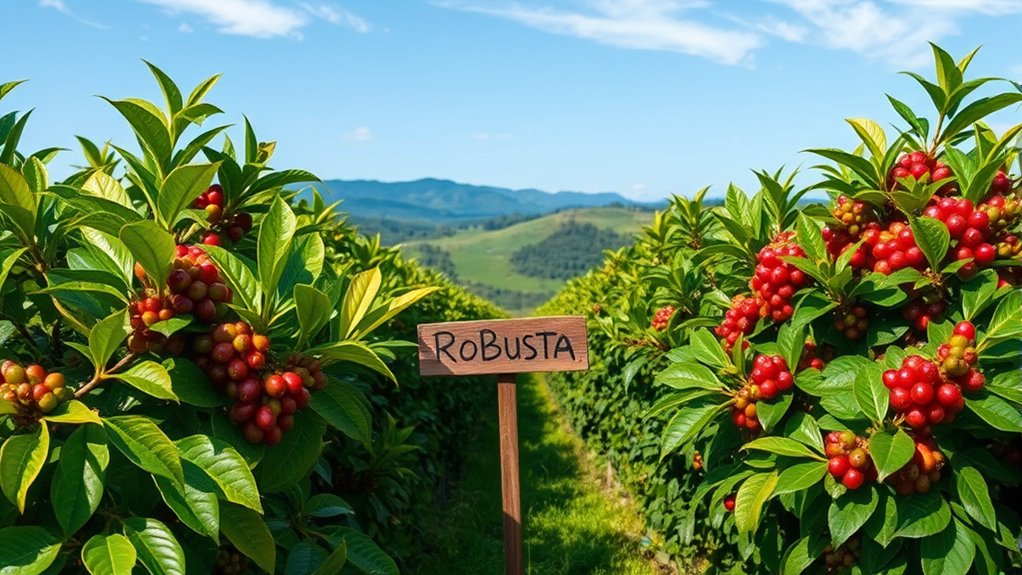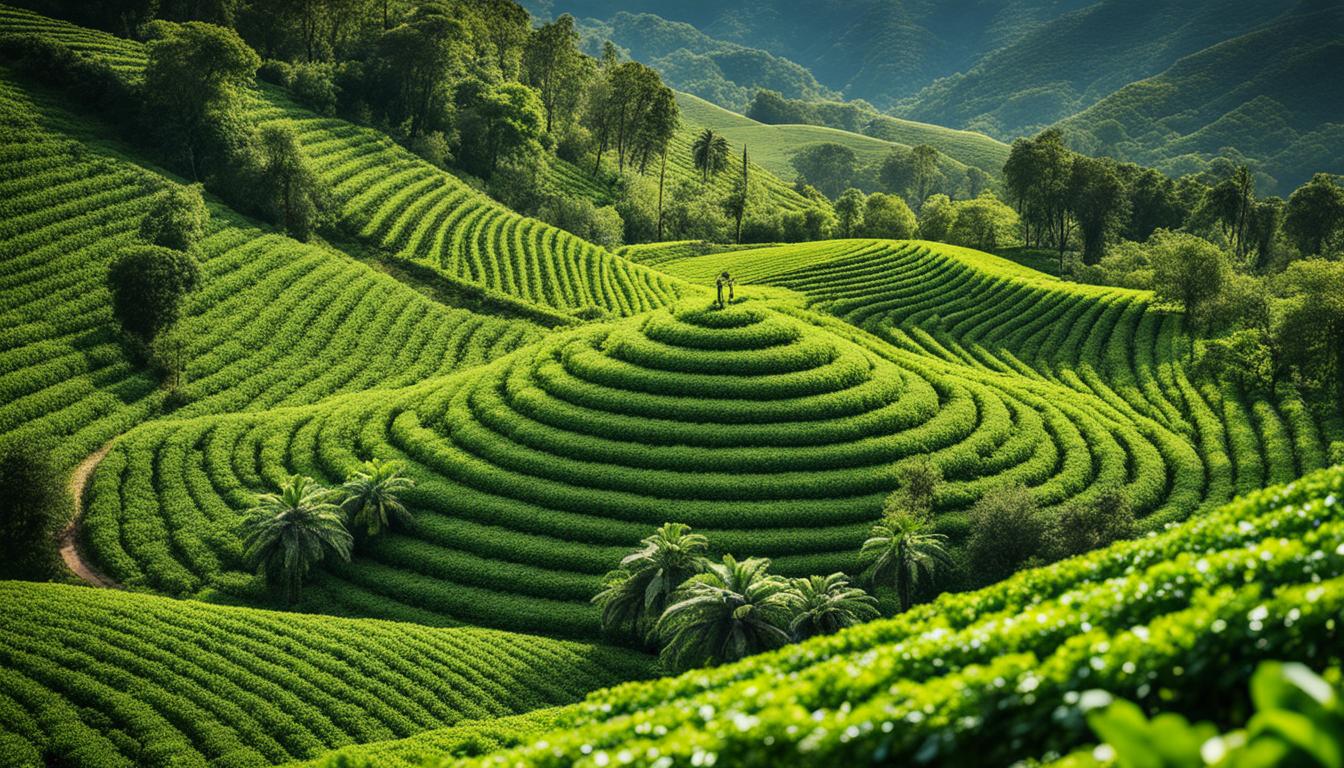By 2025, you’ll see Arabica’s supply face more climate-related challenges, leading to potential price spikes and instability, since it’s the most widely consumed variety. Robusta, being more resilient to environmental stress, will help stabilize overall coffee supply but may be affected by market demand shifts. Understanding these trends will help you grasp how climate change and consumer preferences will shape coffee availability and quality. Stay with us to explore how these dynamics could influence your coffee choices.
Key Takeaways
- Arabica’s vulnerability to climate change may reduce its supply, leading to potential price increases and market instability in 2025.
- Robusta’s resilience helps stabilize global coffee supply, although changing consumer preferences could affect its market share.
- Climate-related challenges are likely to intensify Arabica crop inconsistencies, impacting global availability and pricing dynamics.
- Advances in sustainable, climate-resistant farming could mitigate Arabica supply risks, influencing future market trends.
- Market demand and environmental factors will determine the relative influence of Arabica and Robusta on global coffee supply in 2025.

Have you ever wondered what sets Arabica and Robusta apart? It’s a good question because these two coffee varieties dominate the global market, yet they face very different challenges. As you consider the future of coffee in 2025, understanding these differences becomes even more important, especially in light of ongoing sustainability challenges and price volatility. Arabica, which accounts for around 60-70% of worldwide coffee production, is prized for its smooth, complex flavor profile. However, it’s also more sensitive to environmental conditions, making it vulnerable to climate change. Rising temperatures, unpredictable weather patterns, and pests threaten Arabica crops, pushing farmers to grapple with significant sustainability challenges. These issues aren’t just about crop health; they impact the entire supply chain, leading to uncertainties about future yields. As droughts and storms become more frequent, Arabica production may decline or become more inconsistent, which, in turn, fuels price volatility. When supply drops unexpectedly, prices can spike sharply, creating instability for producers, traders, and consumers alike.
Robusta, on the other hand, is hardier and more resistant to pests and disease. Its ability to thrive in lower altitudes and hotter climates makes it less vulnerable to climate-related disruptions, which can help stabilize supply and prices. However, Robusta is often seen as less refined in flavor, with a stronger, more bitter taste that appeals to specific markets and instant coffee producers. Despite its resilience, Robusta isn’t immune to challenges. The increased demand for more sustainable farming practices requires investment, and many Robusta-producing regions face their own environmental and social hurdles. Additionally, while Robusta tends to have more stable supply, it’s still affected by global price swings driven by fluctuating demand and production costs. This price volatility can impact farmers’ income, which in turn influences farming practices and investment in sustainable methods.
Looking ahead to 2025, the key takeaway is that both Arabica and Robusta face unique hurdles that influence their supply trends. Arabica’s vulnerability to climate change and sustainability challenges could limit its availability, pushing prices higher and making quality more variable. Meanwhile, Robusta’s resilience might keep its supply more steady, but market preferences and environmental concerns will still influence its stability. As you follow these trends, keep in mind that the future of coffee depends on how well producers adapt to these challenges, balancing sustainability with market demands. Both types will continue to evolve, shaping the global coffee landscape in ways that influence your morning cup. Additionally, advancements in climate-resilient farming techniques could help mitigate some of the risks faced by Arabica crops in the future.
Frequently Asked Questions
How Will Climate Change Impact Arabica and Robusta Cultivation?
Climate change will challenge your coffee crops, especially Arabica and Robusta. You’ll need to focus on improving climate resilience and crop adaptation strategies to protect yields. Rising temperatures and unpredictable weather patterns threaten traditional growing regions, so diversifying your plant varieties and adopting sustainable practices become essential. By acting proactively, you can help make sure your coffee plants withstand climate impacts and maintain quality, even as environmental conditions shift rapidly.
What New Technologies Are Influencing Coffee Crop Yields?
You can boost coffee crop yields by adopting precision agriculture and drone monitoring. For example, a Colombian farm uses drones to assess plant health and optimize watering, leading to better yields. These technologies enable precise resource application, early disease detection, and real-time monitoring. By embracing drone monitoring, you can identify issues before they escalate, ensuring healthier crops and more efficient production, which is essential for meeting future global demand.
How Are Fair Trade Practices Evolving in Coffee Sourcing?
You’ll find that fair trade practices are evolving with a stronger focus on sustainable certifications and supporting farmer cooperatives. Companies increasingly prioritize transparency and ethical sourcing, ensuring farmers receive fair wages and better working conditions. By partnering with cooperatives, they promote community development and environmentally friendly methods. This shift encourages consumers to make responsible choices, knowing their coffee supports sustainable practices and improves livelihoods for farmers worldwide.
What Are the Emerging Markets for Specialty Coffee?
Imagine a small village where coffee suddenly became the heartbeat of the economy—that’s happening in emerging markets like Vietnam and Ethiopia. These regions are experiencing remarkable specialty coffee growth, attracting global attention. As consumer preferences shift toward high-quality beans, these markets are transforming into new hubs for specialty coffee. You’ll find opportunities to explore unique flavors and invest in regions that are quickly becoming the future of premium coffee production.
How Might Political Instability Affect Global Coffee Supply Chains?
Political unrest and trade sanctions can disrupt your coffee supply chain by limiting exports, causing delays, and increasing costs. When governments face instability, they may impose restrictions, reducing coffee exports from affected regions. This forces you to seek alternative sources or face shortages. Staying informed about political developments and diversifying your supply sources can help you mitigate these risks and maintain a steady coffee supply despite global uncertainties.
Conclusion
Think of the coffee market as a grand river, where Arabica and Robusta are two mighty currents shaping its flow. As 2025 approaches, understanding their shifts helps you navigate the future with confidence. Just like a seasoned sailor reads the waves, knowing these trends lets you steer through supply changes and market tides. Embrace these insights, and you’ll stay ahead in the ever-changing landscape of coffee’s voyage.









